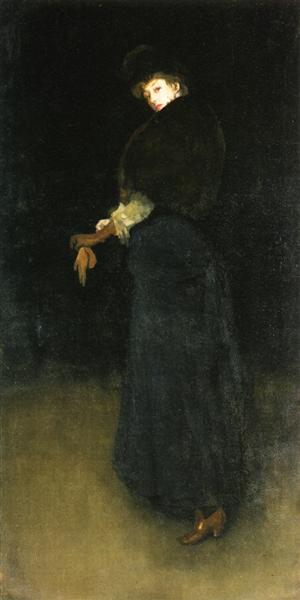Description
James McNeill Whistler, one of the most innovative artists of the nineteenth century, is positioned strongly in the field of modern aesthetics through her work "Black arrangement: the lady of the yellow borceguí" (1883). The painting, a refined manifestation of Whistler's dominance over color and composition, becomes a poetic testimony of his ability to combine simplicity and elegance with almost musical precision.
The piece presents a female figure dressed predominantly in black, with a dark background that highlights the subtlety and complexity of the set. In its traditional approach to the "arrangements", Whistler manipulates tone and light so that the black color does not become a simple abyss of darkness, but a canvas on which various textures and nuances emerge. The presence of the yellow borceguí, which adorns the foot of the lady, acts as a chromatic focus that directs the viewer's gaze, challenging monotony and providing a vibrant and delight contrast.
The face of the woman, serene and contemplative, is an expression of the culture of the Victorian era, where the straight position and the decent bearing underline the search for beauty in everyday life. The work, although apparently austere, hides a complex formal structure where horizontal and vertical lines overlap.
In "Black arrangement: the lady of the yellow borceguí", Whistler not only demonstrates his ability to capture the essence of the subject, but also reflects his artistic philosophy of "art for art." The painting intentionally lacks explicit narrative details, which invites the viewer to a deeper contemplation of color, shape and proportion. This methodology resembles music, an art that Whistler always admired, and in fact, many of his works have titles that evoke musical terms such as "arrangement" or "symphony."
The use of black in the work is not merely decorative, but serves as a field of interaction between light and shadow, creating a delicate game of reflexes and transparencies that enhance the figure of the lady. Whistler's minimalism is, in essence, a search for the sublime in the ordinary, a perpetual exploration of how simple contrast can generate a rich visual experience.
When observing the interaction of Borceguí's golden metal with the dark environment, the viewer can perceive the footprint of Japanese, a significant influence on Whistler's work. Clean lines and detail attention reflect the artist's admiration for Japanese art, which preferred the elegance of the minimum over excessive ornament.
Whistler's painting, although at contemplative and serene times, also raises a subtle criticism of the sociocultural norms of his time, challenging in his statement that beauty can reside in the most sober combination of colors and shapes. This particular work, like many others of its repertoire, not only pursues pure aesthetics, but also offers a space for meditation and introspective appreciation.
In sum, "Black arrangement: the lady of the yellow borceguí" is a celebration of the technical domain and the aesthetic vision of James McNeill Whistler, a painter who revolutionized the way of perceiving color and shape, and that continues to be a central figure In the study of modern art. His legacy lasts in each stroke and each contrast, eternally reminding us of the power of the subtle and the simple in the vast panorama of human creativity.
KUADROS ©, a famous paint on your wall.
Hand-made oil painting reproductions, with the quality of professional artists and the distinctive seal of KUADROS ©.
Art reproduction service with satisfaction guarantee. If you are not completely satisfied with the replica of your painting, we refund your money 100%.

